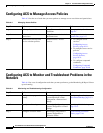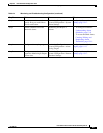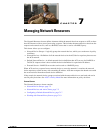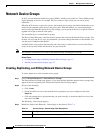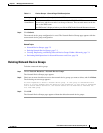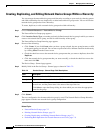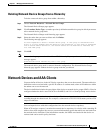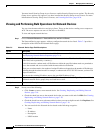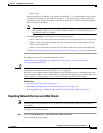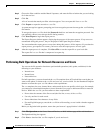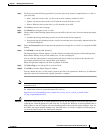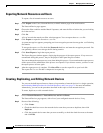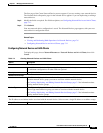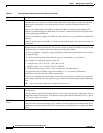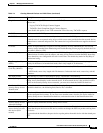
7-6
User Guide for Cisco Secure Access Control System 5.3
OL-24201-01
Chapter 7 Managing Network Resources
Network Devices and AAA Clients
You must install Security Group Access license to enable Security Group Access options. The Security
Group Access options only appear if you have installed the Security Group Access license. For more
information on Security Group Access licenses, see Licensing Overview, page 18-34.
Viewing and Performing Bulk Operations for Network Devices
You can view the network devices and AAA clients. These are the devices sending access requests to
ACS. The access requests are sent via TACACs+ or RADIUS.
To view and import network devices:
Step 1 Choose Network Resources > Network Devices and AAA Clients.
The Network Device page appears, with any configured network devices listed. Table 7-3 provides a
description of the fields in the Network Device page:
Step 2 Do any one of the following:
• Click Create to create a new network device. See Creating, Duplicating, and Editing Network
Devices, page 7-10.
• Check the check box next to the network device that you want to edit and click Edit. See Creating,
Duplicating, and Editing Network Devices, page 7-10.
• Check the check box next to the network device that you want to duplicate and click Duplicate. See
Creating, Duplicating, and Editing Network Devices, page 7-10.
• You can search for the Network devices based on the following categories:
–
Name
–
IP Address
–
Description
–
NDG Location
Table 7-3 Network Device Page Field Descriptions
Option Description
Name User-specified name of network devices in ACS. Click a name to edit the associated network device
(see Displaying Network Device Properties, page 7-14).
IP Address Display only. The IP address or subnet mask of each network device. The first three IP addresses appear
in the field, each separated by a comma (,).
If this field contains a subnet mask, all IP addresses within the specified subnet mask are permitted to
access the network and are associated with the network device definition.
When you use subnet masks, the number of unique IP addresses depends on the number of IP addresses
available through the subnet mask. For example, a subnet mask of 255.255.255.0 means you have 256
unique IP addresses.
You can see the excluded IP address next to the specified IP address if any.
NDG: string Network device group. The two predefined NDGs are Location and Device Type. If you have defined
additional network device groups, they are listed here as well.
Description Display only. Descriptions of the network devices.



